Creating a thriving garden requires mastering proper gardening techniques. In this article, I will share my expert advice and tips to help you achieve a healthy and bountiful garden.
Proper gardening techniques are essential for ensuring your plants thrive and produce a bountiful harvest. By understanding the importance of planning, soil preparation, maintenance tasks, and plant care, you can create a garden that flourishes.
Key Takeaways:
- Scaling your garden in wide rows and practicing crop rotation and companion planting can optimize space and promote plant health.
- Understanding your plants’ needs, including planting and maturity dates, sunlight requirements, and proper planting techniques, is crucial for their success.
- Preparing your soil by finding loam, testing pH and nutrient levels, and adding organic matter or cover crops is essential for healthy plant growth.
- Maintaining your garden through regular tasks such as watering, weeding, and thinning ensures the well-being of your plants.
- Performing daily inspections of your garden and staying organized will keep you motivated and help you stay on track with your gardening goals.
By mastering these proper gardening techniques, you can create a thriving garden that brings beauty and abundance to your outdoor space.
The Importance of Proper Gardening Techniques
Using proper gardening techniques is vital for achieving the best results in your garden. By implementing expert practices, you can ensure the health and success of your plants. The right techniques can make a significant difference in the growth, productivity, and resilience of your garden.
One valuable resource for mastering proper gardening techniques is “The Vegetable Gardener’s Bible” by Edward C. Smith. This comprehensive guide emphasizes the importance of wide rows, organic methods, raised beds, and deep soil. By following these practices, you can create an environment that promotes healthy plant growth and minimizes the risk of pests and diseases.
Planning your garden is another crucial step in ensuring gardening success. Scaling your garden in wide rows with taller plants on the north side maximizes sunlight exposure and provides optimal growing conditions. Additionally, planting what you eat, practicing crop rotation and companion planting, and utilizing succession planting can help improve soil health, manage pests, and achieve a bountiful harvest throughout the growing season.
Understanding the specific needs of your plants is essential for their overall well-being. Knowing their planting and maturity dates, sunlight requirements, and proper planting techniques will enable you to provide the ideal conditions for their growth. Taking the time to research and learn about the individual requirements of each plant will greatly contribute to their long-term success in your garden.

Expert Tip: Planting Properly for Optimal Plant Health
When it comes to planting, proper techniques are crucial for the health and growth of your plants. Ensuring proper spacing between plants allows for adequate air circulation and reduces the risk of disease. Mulching around your plants helps retain moisture, suppresses weeds, and maintains an even soil temperature. This technique also adds organic matter to the soil as it breaks down, further enriching the growing environment.
By implementing these expert gardening techniques, you can create a thriving garden that yields healthy and abundant crops. Stay tuned for the next section, where we will explore the importance of preparing your soil for healthy growth and delve into organic gardening methods and sustainable practices.
| Key Points | Benefits |
|---|---|
| Wide rows, organic methods, raised beds, deep soil | Promotes healthy plant growth and minimizes pests and diseases |
| Scaling garden in wide rows, companion planting, crop rotation | Improves soil health, manages pests, and ensures a continuous harvest |
| Understanding plants’ needs and planting techniques | Provides optimal conditions for growth and overall plant well-being |
| Proper spacing and mulching | Enhances plant health, reduces disease risk, and conserves moisture |
Planning Your Garden for Success
Proper planning is the foundation for a successful garden. In this section, I will share efficient gardening strategies and tips to help you maximize your garden’s potential. By implementing these techniques, you can create a thriving and productive space for your plants to flourish.
One effective strategy is to scale your garden in wide rows, with taller plants positioned on the north side to prevent shading. This arrangement allows for better sunlight exposure, optimizing plant growth. Additionally, planting what you eat ensures that you are growing crops that you will use and enjoy, reducing waste and maximizing the value of your garden.
Crop rotation and companion planting are also essential techniques for successful gardening. By rotating your crops each year, you can prevent the buildup of pests and diseases in the soil, promoting healthier plants. Companion planting, on the other hand, involves pairing compatible plants together to enhance growth, deter pests, and improve yields. For example, planting marigolds alongside tomatoes can repel harmful insects and boost tomato production.
Succession planting
Another efficient gardening strategy is succession planting. This technique involves staggering the planting of crops so that you have a continuous supply throughout the growing season. By planting new seeds or seedlings as soon as previous crops are harvested, you can maximize your garden’s productivity and make the most of limited space.
| Crop | Planting Time | Harvest Time |
|---|---|---|
| Spinach | Early spring | Early summer |
| Lettuce | Spring | Summer |
| Carrots | Spring | Summer |
By planning your garden with these efficient strategies in mind, you can create a thriving and productive oasis. Stay tuned for the next section, where I will discuss the importance of understanding your plants’ specific needs and how to provide them with the best care.
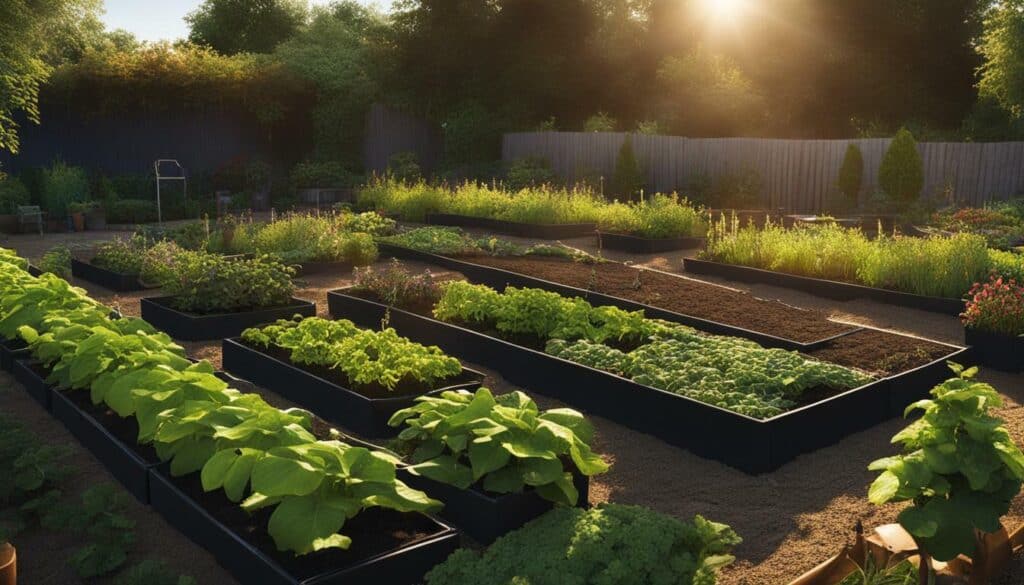
Understanding Your Plants’ Needs
To ensure your plants thrive, it is essential to understand their unique requirements. In this section, I will guide you through the critical factors to consider when growing different types of plants.
One of the first things to consider is the planting and maturity dates of your plants. Some plants prefer to be started indoors and transplanted outside once the risk of frost has passed, while others can be directly sown into the garden. It’s important to follow the recommended planting times for each specific plant to give them the best chance of success.
Sunlight requirements also play a significant role in your plants’ growth. Some plants thrive in full sun, while others prefer partial shade. Make sure to read the seed packet or plant label to determine the ideal sunlight conditions for your plants. Properly placing your plants in the garden according to their sunlight needs will help them reach their full potential.
Lastly, understanding proper planting techniques is crucial for your plants’ health. Each plant has different spacing requirements. Be sure to give them enough room to grow and access to adequate nutrients and sunlight. Mulching around the base of your plants can help conserve moisture and suppress weeds. Utilizing organic mulch, such as straw or wood chips, will also add nutrients to the soil as it breaks down over time.
| Plant Type | Planting Depth | Spacing (inches) |
|---|---|---|
| Tomatoes | 1/4 inch | 24-36 inches |
| Lettuce | 1/4 inch | 6-12 inches |
| Carrots | 1/4 inch | 2-4 inches |
Expert Tip:
When planting your garden, consider incorporating companion planting. This technique involves growing mutually beneficial plants together, such as planting marigolds near tomatoes to deter pests. Companion planting can enhance plant growth, increase pollination, and help control pests naturally.
By understanding your plants’ needs and implementing proper planting techniques, you’ll set them up for successful growth. Take the time to research and plan accordingly, and you’ll be rewarded with a beautiful and bountiful garden.
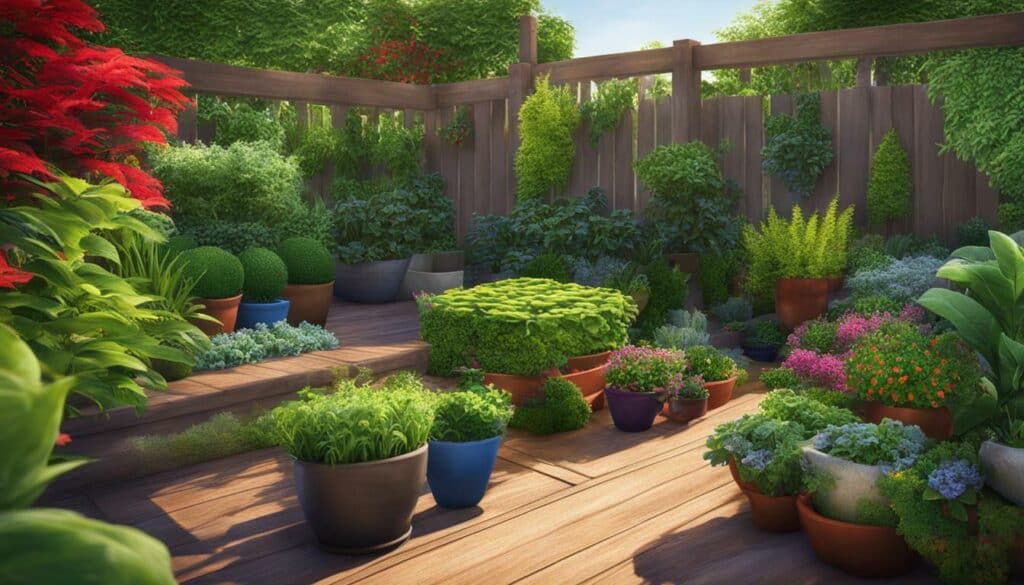
Preparing Your Soil for Healthy Growth
Healthy soil is the key to a thriving garden. In this section, I will share organic and sustainable gardening practices to help you create a nutrient-rich soil environment. By following these techniques, you can improve soil structure, promote optimal plant growth, and reduce the need for chemical fertilizers and pesticides.
One of the first steps in preparing your soil is finding loam, which is a balanced combination of sand, silt, and clay. Loam provides good drainage and moisture retention, allowing plant roots to access water and nutrients without becoming waterlogged. You can test for loam by taking a handful of soil and squeezing it. If it holds together without forming a solid clump, that’s a good indication that you have loamy soil.
Testing your soil’s pH and nutrient levels is also essential. You can use a soil test kit or send a sample to a local agricultural extension service for analysis. Once you know your soil’s pH and nutrient content, you can make necessary adjustments. Adding organic matter such as compost, well-rotted manure, or leaf mold can improve soil fertility and texture. Cover crops like legumes and grasses can also be planted to add organic matter and fix nitrogen in the soil.
| Organic Gardening Practices | Sustainable Gardening Practices |
|---|---|
| Use compost and organic fertilizers instead of synthetic chemicals. | Practice water conservation by using mulch and collecting rainwater. |
| Encourage beneficial insects and pollinators by planting native flowers and providing habitat. | Practice integrated pest management by using natural predators, traps, and barriers. |
| Avoid tilling the soil to preserve its structure and minimize soil erosion. | Plant native and drought-tolerant species to reduce water consumption. |
Quote: “The greatness of a nation and its moral progress can be judged by the way its animals are treated.” – Mahatma Gandhi
Additional Tips for Soil Preparation
- Remove any weeds or grass from the designated garden area before starting.
- Consider raised bed gardening to improve soil drainage and minimize weed growth.
- Apply a layer of mulch, such as straw or wood chips, to suppress weeds, retain moisture, and regulate soil temperature.
- Rotate your crops each year to prevent the buildup of pests and diseases.
- Regularly monitor your soil moisture levels and adjust watering accordingly.
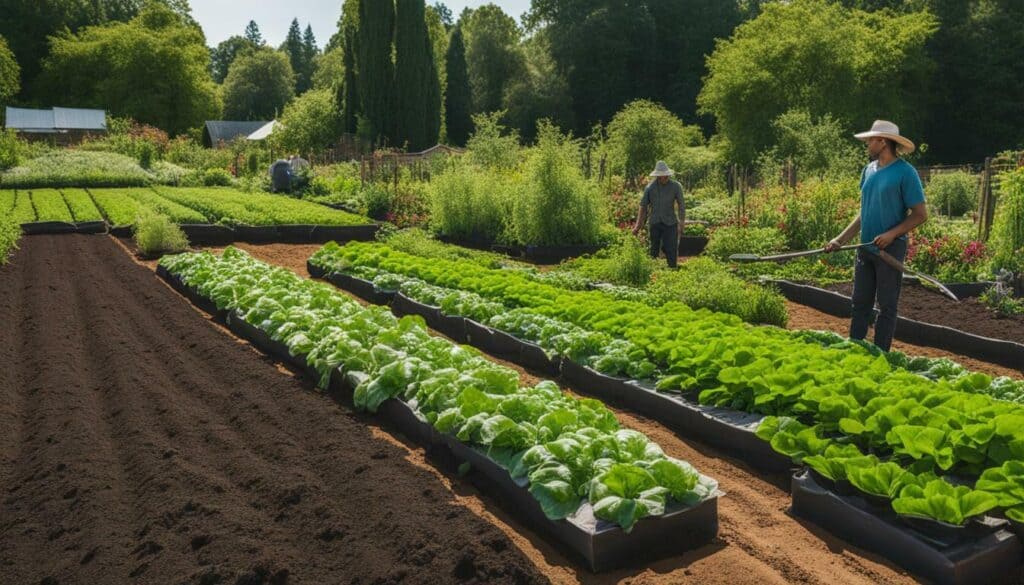
Creating a healthy soil foundation will provide a solid base for your plants to flourish. By implementing organic and sustainable gardening practices, you can ensure the long-term health and productivity of your garden while minimizing impact on the environment.
Regular Maintenance Tasks for Garden Health
Maintaining a healthy garden requires consistent care and attention. In this section, I will provide valuable tips on how to effectively perform maintenance tasks to keep your garden in top shape.
One of the most important tasks in garden maintenance is watering. Plants need a consistent and adequate water supply to thrive. To simplify the watering process, set up a routine that suits your garden’s needs. Pay attention to the moisture level of the soil and adjust your watering schedule accordingly. Using the right tools, such as a watering can or a drip irrigation system, can help ensure that water is distributed evenly and efficiently to your plants.
Weeding is another essential task for maintaining a healthy garden. Weeds compete with your plants for nutrients, water, and sunlight, so it’s important to stay on top of them. Regularly inspect your garden for weeds and remove them promptly. Consider using mulch to help suppress weed growth and conserve moisture in the soil.
Thinning is a practice that can greatly benefit your plants. Overcrowded plants can lead to poor air circulation, increased risk of diseases, and reduced yields. By thinning out your plants, you allow them to have enough space to grow and flourish. Carefully remove weaker or excess seedlings, leaving only the strongest plants to thrive.
| Maintenance Tasks | Benefits |
|---|---|
| Watering | Ensures plants receive adequate moisture |
| Weeding | Reduces competition for nutrients and sunlight |
| Thinning | Allows plants to have enough space to grow |

By incorporating these regular maintenance tasks into your gardening routine, you can ensure the health and success of your garden. Remember to water your plants consistently, remove weeds promptly, and thin out your plants as needed. With proper care and attention, your garden will thrive and reward you with beautiful blooms and bountiful harvests.
Daily Inspections and Motivation in the Garden
Daily inspections in your garden can be the key to success. In this section, I will reveal expert techniques to help you stay motivated and productive in your gardening endeavors. By incorporating these simple practices into your routine, you can ensure that your garden thrives and enjoy the rewards of your hard work.
Begin your day with a morning stroll through your garden, taking note of any changes or developments. This daily ritual will not only allow you to closely monitor the progress of your plants but also provide a sense of connection with nature. Take the time to observe the intricate details of each plant, from new growth to budding flowers. These moments of reflection can be inspiring and fuel your motivation to continue nurturing your garden.
Make a mental checklist of tasks that need to be addressed during your inspection. This could include watering, pruning, or identifying any signs of pests or diseases. By staying organized and proactive, you can address issues promptly and prevent them from spreading or causing further damage. Consider keeping a gardening journal to record your observations and track the progress of your plants over time.
Expert Tip: Create a Scenic Spot in Your Garden
Creating a designated spot in your garden where you can sit and enjoy the beauty of your surroundings can boost your motivation and provide a peaceful retreat. Choose a comfortable chair or bench and strategically place it in an area with a picturesque view. Surround yourself with fragrant flowers or a tranquil water feature to enhance the ambiance. This spot can serve as a sanctuary where you can relax, reflect, and draw inspiration from the wonders of nature.

Remember, gardening is a journey, and each day brings new discoveries and challenges. By incorporating daily inspections into your routine, you can stay connected to your garden, nurture its growth, and reap the rewards of a thriving oasis right in your own backyard.
Organization and Planning for Efficiency
Being organized and planning ahead can greatly improve your gardening efficiency. In this section, I will share valuable tips to help you stay on track and make the most of your gardening time.
One effective way to stay organized is by keeping a list of tasks. Make a to-do list at the beginning of each week, outlining the specific gardening tasks you need to accomplish. This will help you prioritize your activities and ensure that nothing gets overlooked. As you complete each task, check it off the list, giving you a sense of accomplishment and motivation to move on to the next.

Having your gardening tools readily accessible is another key aspect of organization. Nothing slows you down more than having to search for the right tool when you need it. Invest in a sturdy garden tool organizer or create a designated area in your garden shed where you can hang and store your tools. This way, you’ll always know where to find them when you need them, saving you time and frustration.
Proper Planting Techniques for Healthy Growth
Planting your garden correctly is essential for the health and success of your plants. In this section, I will guide you through proper planting techniques to promote healthy growth. By following these expert gardening techniques, you can ensure that your plants thrive and flourish.
Spacing and Mulching
Proper spacing is crucial to allow your plants to receive adequate sunlight, air circulation, and nutrients. Be sure to follow the recommended spacing guidelines for each plant variety, as overcrowding can lead to stunted growth and increased risk of disease. Additionally, mulching around your plants can help conserve moisture, suppress weeds, and regulate soil temperature.
Watering Tips
Watering your plants correctly is vital for healthy growth. Aim to water your plants deeply and infrequently, rather than providing frequent shallow waterings. This encourages the development of deep root systems, which helps plants withstand drought conditions. Utilizing a watering wand or drip irrigation system can ensure that water reaches the root zone without wetting the foliage, reducing the risk of fungal diseases.
Fertilizing Techniques
Proper fertilization is essential for providing your plants with the nutrients they need to thrive. Before planting, mix in organic matter such as compost or well-rotted manure to enrich the soil. During the growing season, consider using slow-release organic fertilizers that provide a steady supply of nutrients over time. Be sure to follow the recommended application rates to prevent nutrient imbalances and avoid burning your plants.
Remember, mastering these proper planting techniques is key to creating a healthy and thriving garden. Take the time to plan and prepare your garden beds, ensuring proper spacing, mulching, and watering techniques. By following these expert gardening techniques, you can enjoy the beauty and abundance of a flourishing garden.
| Planting Tips | Fertilizing Tips | Watering Tips |
|---|---|---|
| Follow recommended spacing guidelines | Mix in organic matter before planting | Water deeply and infrequently |
| Use mulch to conserve moisture and suppress weeds | Consider slow-release organic fertilizers | Use a watering wand or drip irrigation system |
| Prevent overcrowding for proper air circulation | Follow recommended application rates | Avoid wetting the foliage |
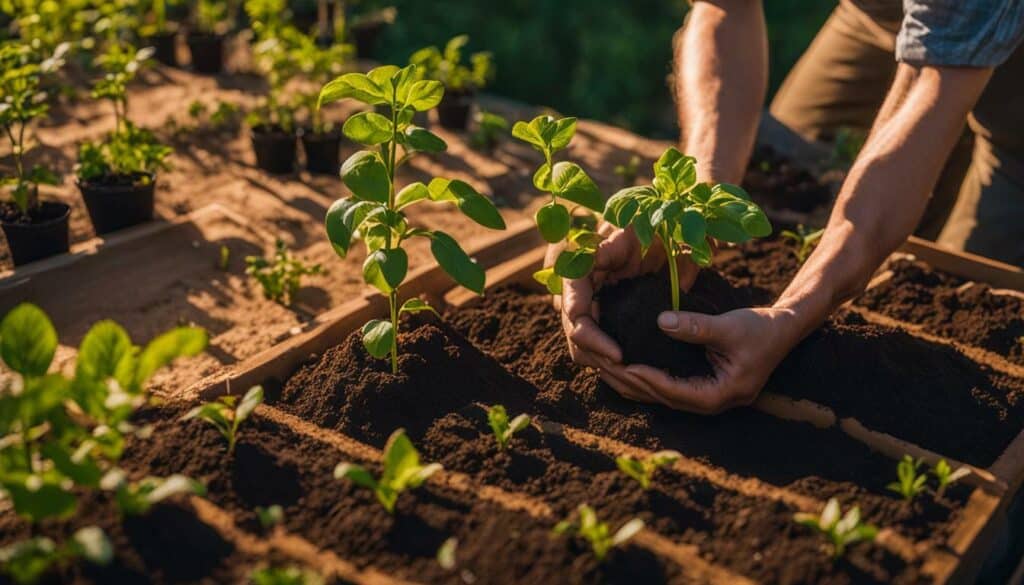
Simplifying Watering with the Right Routine and Tools
Providing adequate water to your plants is crucial for their survival and growth. In this section, I will share efficient watering strategies and tips to simplify this essential task in your garden. By following these best practices, you can ensure that your plants receive the right amount of water at the right time, promoting healthy and thriving growth.
1. Set up a watering routine: Establishing a consistent watering schedule is key to maintaining optimal soil moisture levels. Water your plants deeply and infrequently to encourage deep root growth. Depending on the weather conditions and the specific needs of your plants, you may need to adjust the frequency and duration of watering. Remember to water in the early morning or late afternoon to minimize evaporation and prevent disease.
2. Use the right tools: Investing in the right watering tools can make a significant difference in the efficiency and effectiveness of your watering routine. Consider using a soaker hose or drip irrigation system to deliver water directly to the root zone, reducing water waste and promoting deep root penetration. A watering wand or nozzle with adjustable settings can provide more control and precision in directing the water flow.
3. Mulch to conserve moisture: Applying a layer of organic mulch around your plants can help retain soil moisture, prevent weed growth, and regulate soil temperature. Choose mulch materials such as wood chips, straw, or shredded leaves and spread them evenly around the base of your plants. Mulching also helps to prevent soil erosion and improve the overall health of your garden.
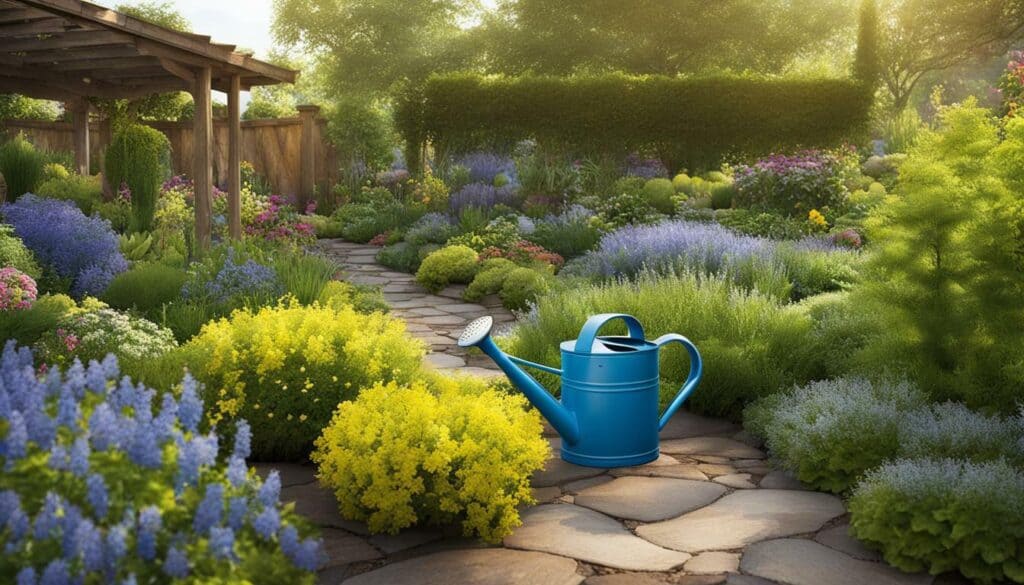
By implementing these efficient watering strategies and using the right tools, you can simplify the watering process in your garden. Remember to tailor your watering routine to the specific needs of your plants and monitor soil moisture levels regularly. With proper watering, your plants will thrive and reward you with vibrant growth and bountiful harvests.
Conclusion
Mastering proper gardening techniques is the key to a thriving garden. By implementing the expert tips and advice shared in this article, you can create a healthy and bountiful garden of your dreams.
Good gardening resources, such as “The Vegetable Gardener’s Bible” by Edward C. Smith, offer valuable information and guidance. This book emphasizes the importance of wide rows, organic methods, raised beds, and deep soil to promote optimal plant growth.
Planning your garden is crucial for success. Scaling your garden in wide rows with taller plants on the north side maximizes sunlight exposure. Planting what you eat, practicing crop rotation and companion planting, and utilizing succession planting are efficient strategies that lead to higher yields and stronger, more resilient plants.
Understanding your plants’ specific needs is essential. Knowing their planting and maturity dates, sunlight requirements, and proper planting techniques enables you to provide the ideal conditions for their growth.
Preparing your soil properly sets the foundation for healthy plant growth. Finding loam, testing soil pH and nutrient levels, and adding organic matter or cover crops replenish essential nutrients and create a fertile environment.
Regular maintenance tasks, such as watering, weeding, and thinning, should not be overlooked. By staying on top of these essential tasks, you can ensure the health and vitality of your garden.
Make it a habit to perform daily inspections in your garden. Starting early in the morning, these inspections not only provide motivation but also allow you to catch any issues early on, ensuring a productive and flourishing garden.
Stay organized and plan ahead to maximize efficiency. Keep a list of tasks, have readily accessible tools, and ensure your trash and compost containers are nearby for easy waste disposal.
Proper planting techniques are crucial for healthy plant growth. Take care to space your plants adequately and mulch them to retain moisture and suppress weeds.
Finally, simplify your watering routine by setting up a schedule and using the right tools. This will ensure that your plants receive the right amount of water and promote efficient water usage.
By mastering these proper gardening techniques, you can create a garden that thrives and brings you joy. So, roll up your sleeves, get your hands dirty, and enjoy the journey of growing your own green oasis!
What Are Some Essential Tools and Equipment for Proper Gardening Techniques?
To create a lush and thriving garden, having the right tools and equipment is essential. From basic essentials like a shovel, pruning shears, and watering can, to more specialized items such as a soil tester and gardening gloves, each tool plays a vital role in maintaining a green paradise. Whether you are a beginner or an experienced gardener, investing in these essential garden items for green paradise will surely elevate your gardening techniques and ensure your plants flourish.
FAQ
Q: What are some good resources for gardening information?
A: “The Vegetable Gardener’s Bible” by Edward C. Smith is an excellent resource that emphasizes wide rows, organic methods, raised beds, and deep soil.
Q: Why is planning your garden important?
A: Planning your garden is crucial for success. Scaling your garden in wide rows with taller plants on the north side, planting what you eat, practicing crop rotation and companion planting, and utilizing succession planting are all important strategies to consider.
Q: How can I understand my plants’ needs?
A: It is important to know your plants’ planting and maturity dates, sunlight requirements, and planting techniques. This knowledge will help ensure their success in your garden.
Q: Why is soil preparation important for healthy plant growth?
A: Preparing the soil by finding loam, testing its pH and nutrient levels, and adding organic matter or cover crops will promote healthy plant growth and provide them with the necessary nutrients they need to thrive.
Q: What maintenance tasks should I perform regularly in my garden?
A: Regular maintenance tasks like watering, weeding, and thinning should be performed regularly to maintain a healthy garden. These tasks help ensure that your plants have the space and nutrients they need to grow strong and productive.
Q: How can I stay motivated and productive in my garden?
A: Making daily inspections of your garden, starting early in the morning, and envisioning the possibilities can provide motivation and ensure productivity. It is also helpful to keep a list of tasks and have trash and compost containers nearby.
Q: What are some proper planting techniques for healthy growth?
A: Properly spacing your plants and mulching are essential for healthy growth. These techniques allow for good air circulation and help to prevent weed growth.
Q: How can I simplify the watering process in my garden?
A: Setting up a watering routine and using the right tools can simplify the watering process. Consistency and using tools that effectively distribute water to your plants will ensure they receive the proper amount of water they need to thrive.
Q: How can I create a thriving garden?
A: By mastering proper gardening techniques such as planning, understanding your plants’ needs, preparing the soil, regular maintenance, staying motivated, and proper planting and watering techniques, you can create a thriving garden full of healthy and productive plants.

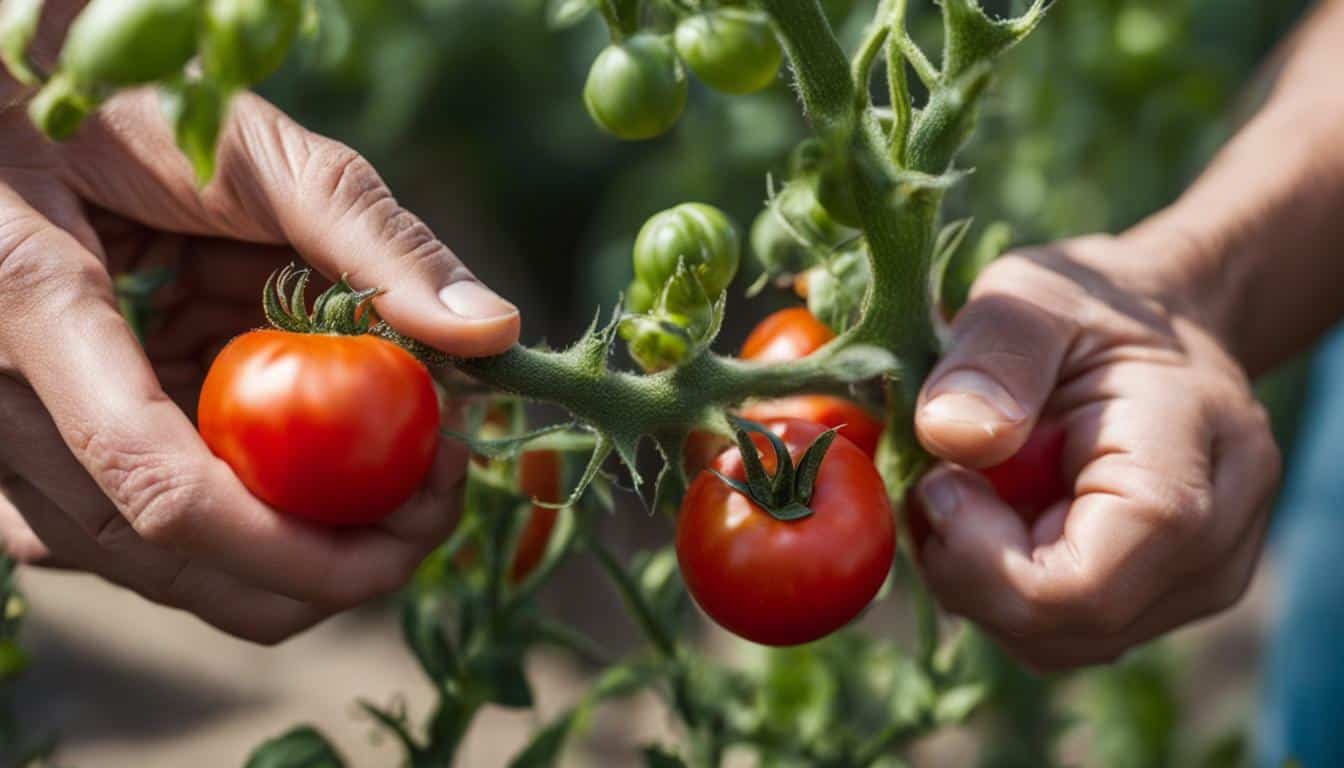



Leave a Reply